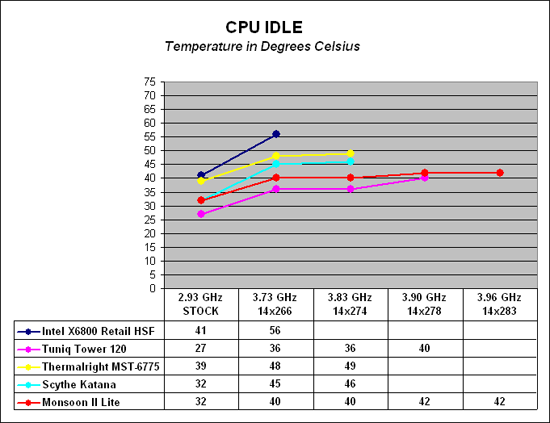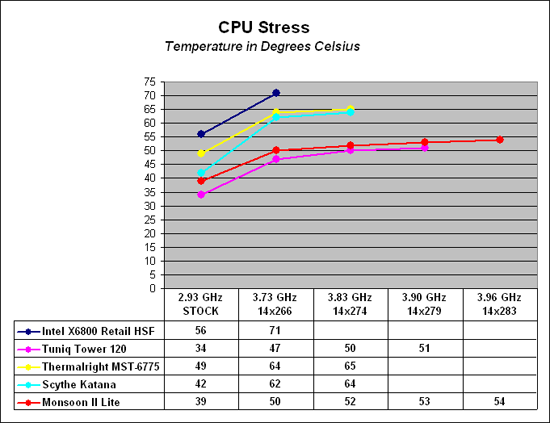Monsoon II Lite: Thermal Electric Cooling Tower
by Wesley Fink on February 6, 2007 6:00 AM EST- Posted in
- Cases/Cooling/PSUs
Cooling Results
The Vigor Monsoon II Lite is certainly one of the most effective coolers we have tested, reaching new overclock levels and matching or bettering the best performance so far in cooling.

Where the very good Intel stock cooler keeps the X6800 at 41C at idle, the Monsoon II Lite maintains 32C, which is a significant improvement. This is not quite as cool as the Tuniq Tower 120 at stock idle, but the practical difference between the 27C we measured with the Tuniq Tower 120 and the 32C measured with the Monsoon II Lite is not very significant when the design parameters of the Monsoon II TEC are considered. As processor speed increases the Tuniq and Monsoon II get closer in cooling, so that at 3.90Ghz the Tuniq is 40C and the Monsoon is 42C. The Monsoon also overclocks further to 3.96GHz.
As the processor is pushed to its highest stable overclock using the retail HSF, the delta increases. At 3.73GHz the retail HSF is running at 56C, compared to 40C with the Monsoon II. The Monsoon II and Tuniq Tower 120 perform similarly at idle speeds across the operating speeds they can achieve.
It is easy to measure the effectiveness of a cooling solution at idle - when the computer is doing nothing except running the temperature measurement program. It is more difficult, however, to effectively simulate a computer being stressed by all of the conditions it might be exposed to in different operating environments. For most home users CPU power is most taxed with contemporary gaming. Therefore our stress test simulates running a demanding game. The Far Cry River demo is looped for 30 minutes and the CPU temperature is captured at four second intervals with the NVIDIA Monitor "logging" option. The highest temperature during the stress test is then reported.
Cooling efficiency of the Monsoon II Lite under stress conditions was compared to the retail HSF and other recently tested CPU coolers. Once again the well-regarded Tuniq Tower 120 and the Monsoon II Lite were the top performers. It is interesting that the Tuniq and Monsoon II results got closer as the CPU speed under stress conditions reached higher.

The Tuniq keeps the CPU at 34C under stress at stock speeds, where the Monsoon II manages 39C. However, by 3.90GHz the Tuniq is at 51C compared to the Monsoon II at 53C - much closer results. Only the Tuniq and Monsoon II were able to reach 3.9GHz with this processor, but the Monsoon II Lite system allowed an even higher overclock of 3.96GHz, which is the highest we have reached with this CPU.
As stated many times, the overclocking abilities of the CPU will vary at the top, depending on the CPU. This particular CPU does higher FSB speeds than any X6800 we have tested, but the 3.9GHz top speed with the Tuniq is pretty average among the X6800 processors we have tested with Tuniq cooling. A few of the other processors tested with the best air coolers reach just over 4 GHz, but the range has been 3.8 to 4.0GHz. Stock cooling generally tops out 200 to 400 MHz lower, depending on the CPU, on the processors tested in our lab. The 3.96GHz with the Monsoon II is certainly the highest this CPU has seen so far.
The Vigor Monsoon II Lite is certainly one of the most effective coolers we have tested, reaching new overclock levels and matching or bettering the best performance so far in cooling.

Where the very good Intel stock cooler keeps the X6800 at 41C at idle, the Monsoon II Lite maintains 32C, which is a significant improvement. This is not quite as cool as the Tuniq Tower 120 at stock idle, but the practical difference between the 27C we measured with the Tuniq Tower 120 and the 32C measured with the Monsoon II Lite is not very significant when the design parameters of the Monsoon II TEC are considered. As processor speed increases the Tuniq and Monsoon II get closer in cooling, so that at 3.90Ghz the Tuniq is 40C and the Monsoon is 42C. The Monsoon also overclocks further to 3.96GHz.
As the processor is pushed to its highest stable overclock using the retail HSF, the delta increases. At 3.73GHz the retail HSF is running at 56C, compared to 40C with the Monsoon II. The Monsoon II and Tuniq Tower 120 perform similarly at idle speeds across the operating speeds they can achieve.
It is easy to measure the effectiveness of a cooling solution at idle - when the computer is doing nothing except running the temperature measurement program. It is more difficult, however, to effectively simulate a computer being stressed by all of the conditions it might be exposed to in different operating environments. For most home users CPU power is most taxed with contemporary gaming. Therefore our stress test simulates running a demanding game. The Far Cry River demo is looped for 30 minutes and the CPU temperature is captured at four second intervals with the NVIDIA Monitor "logging" option. The highest temperature during the stress test is then reported.
Cooling efficiency of the Monsoon II Lite under stress conditions was compared to the retail HSF and other recently tested CPU coolers. Once again the well-regarded Tuniq Tower 120 and the Monsoon II Lite were the top performers. It is interesting that the Tuniq and Monsoon II results got closer as the CPU speed under stress conditions reached higher.

The Tuniq keeps the CPU at 34C under stress at stock speeds, where the Monsoon II manages 39C. However, by 3.90GHz the Tuniq is at 51C compared to the Monsoon II at 53C - much closer results. Only the Tuniq and Monsoon II were able to reach 3.9GHz with this processor, but the Monsoon II Lite system allowed an even higher overclock of 3.96GHz, which is the highest we have reached with this CPU.
As stated many times, the overclocking abilities of the CPU will vary at the top, depending on the CPU. This particular CPU does higher FSB speeds than any X6800 we have tested, but the 3.9GHz top speed with the Tuniq is pretty average among the X6800 processors we have tested with Tuniq cooling. A few of the other processors tested with the best air coolers reach just over 4 GHz, but the range has been 3.8 to 4.0GHz. Stock cooling generally tops out 200 to 400 MHz lower, depending on the CPU, on the processors tested in our lab. The 3.96GHz with the Monsoon II is certainly the highest this CPU has seen so far.










19 Comments
View All Comments
nickfd - Tuesday, February 6, 2007 - link
Can you post a review/link to review for this cooler?Wesley Fink - Tuesday, February 6, 2007 - link
The Freezone is in our testing calendar and it will definitely be compared to the Monsoon II Lite.jvuser - Tuesday, February 6, 2007 - link
It is not recommended to run TEC/peltiers by thermostatic switching. This leads to excessive stresses and preliminary failure. See datasheets at www.marlow.com.DrMrLordX - Tuesday, February 6, 2007 - link
Reviews I've seen of the original Vigor Monsoon II seem to reflect your findings, except:1). The Monsoon II works much better when modded to work with a better 92mm fan (not easy to do)
2). The Monsoon II works better in cases with good airflow
You didn't mention the case or case fans used, and you barely showed a picture of the test system. Could you please elabourate on the airflow situation in which you tested the Monsoon II? Also, are you able to include a Titan Amanda in your test as well?
It is good that the Monsoon II will now be available at a lower price.
RobFDB - Tuesday, February 6, 2007 - link
From your results the only advantage the Monsoon II Lite seems to give the EU is maybe 60 more mhz. Aside from that it costs more than the Tuniq 120, it doesn't cool as well, it adds 50w of power to your overall consumption and it's noisier. Sure it's an innovative idea, but it doesn't actually help out the EU.Jodiuh - Tuesday, February 6, 2007 - link
Exactly what I wanted to say. I'm one of those "will give up OC for a nice quiet room" guys. And I actually replaced the Tuniq fan w/ a Scythe SFLEX. :DSurJector - Tuesday, February 6, 2007 - link
I totally agree as well. Additionally the sentenceis incorrect: the air cooler has to cool 49 more W. If the processor consumes 150W and the Peltier element 49W (leaving 1W for the fan), then the radiator has 199W to cool down instead of 150W. It is very tricky to cool down a Peltier element without noise. In that case, I would say that they did not succeed: the processor is warmer and the fan noisier. The additional 60MHz (i.e. 1.5%) look insignificant, at least to me.
Wesley Fink - Tuesday, February 6, 2007 - link
The noise level with the TEC and fan running at full speed is still much lower than the stress sound levels we measured. Most of the added noise is the buzzing, pops, and clicks from the fan being controlled simultaneously with the TEC. As we said in the review the fan running continously is much quieter.Vigor says they are aware of the issues and they are working to separately control the fan and TEC with the controller. This will definitely reduce noise levels.
DigitalFreak - Tuesday, February 6, 2007 - link
I totally agree. While it's a novel idea, the only plus it has over the Tuniq 120 is an extra 60Mhz overclock. When I get my C2D or C2Q system, I'm going with the Tuniq.